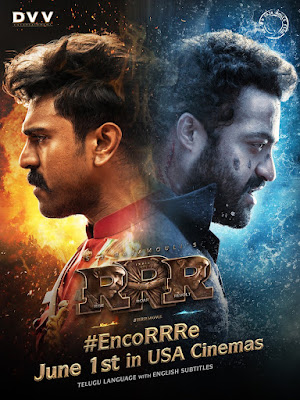It is one of the highest grossing Indian films of all-time and it was partly shot in Ukraine, but apparently that didn’t mean much to the government of the “world’s largest democracy” when Putin invaded. After all, shooting had already wrapped, on a picture that ironically protests the brutality of British imperialism. In this action epic, the British probably lose more soldiers than they did at Bunker Hill. Such an incident would have surely led to a parliamentary inquiry, especially since a regional governor precipitated the whole mess by abducting a young girl. That just isn’t cricket, you know? Two legendary early Twentieth Century revolutionaries form a fictional friendship and team-up against the British in S.S. Rajaouli’s RRR (a.k.a. Rise Roar Revolt), which has a special one-day return to American theaters this Wednesday.
Governor Scott Buxton and his Lady Macbeth-esque wife Catherine happened to hear a young Gond singer during their trip to Telangana, so they just figured they’d take her with them as a souvenir. As the “shepherd” of the tribe, it is Komaram Bheem’s sworn duty to find her and safely bring her back. To do so, he naturally falls in with Delhi’s revolutionary circles. Unfortunately, his brother comes to the attention of A. Rama Raju (better known as Alluri Sitarama Raju), who was then a hard-charging Indian officer, but secretly harbored revolutionary ambitions.
While chasing Bheem’s brother, Raju stops to rescue an endangered street urchin, with the oblivious help of Bheem himself. Being men of action, a fast-friendship blossoms between them, but when Bheem launches his rescue operation, it forces Raju to make a series of soul-searching decisions.
Despite the patriotic themes (critics would call RRR jingoistic if it were made in America), the reason it traveled so well outside of the subcontinent is the off-the-wall action. The sequences involving CGI-animals might even be a little too off-the-wall, but perhaps they look better on a more spacious big screen. Still, our introduction to Raju is quite a barn-burner and incidentally also a good lesson in crowd control. Arguably, the whole thing morphs into a super-hero movie during the climax, when they become invested with the powers of Lord Rama, but it certainly makes for some wild spectacle.
There is a little bit of frustrated romance, but mostly the men keep to their subversive business. Be that as it may, Olivia Morris still brings some decent energy and presence to the film as Jenny, the Buxton’s progressive niece and Bheem’s short-lived love interest. Of the two action leads, Ram Charan burns somewhat brighter and fiercer as Raju than N.T. Rama Rao Jr as the somewhat moodier Bheem, but they both have plenty of muscle and testosterone. Unfortunately, the Buxtons are total cliches that neither Ray Stevenson or Alison Doody (from The Last Crusade) manage to liven-up to any great degree.
So, if colonialism is bad, why is it acceptable to the Indian government when Putin tries to do it in Ukraine—by levelling entire apartment buildings? Also, why aren’t the film critics who added Ukraine flags to their social media profiles asking that question? There is a lot to enjoy in RRR, but it does not exist in a vacuum. RRR is recommended for its action, but think about the circumstances surrounding it while you’re watching it—when RRR returns to theaters this Wednesday (6/1), including the IFC Center in New York.

